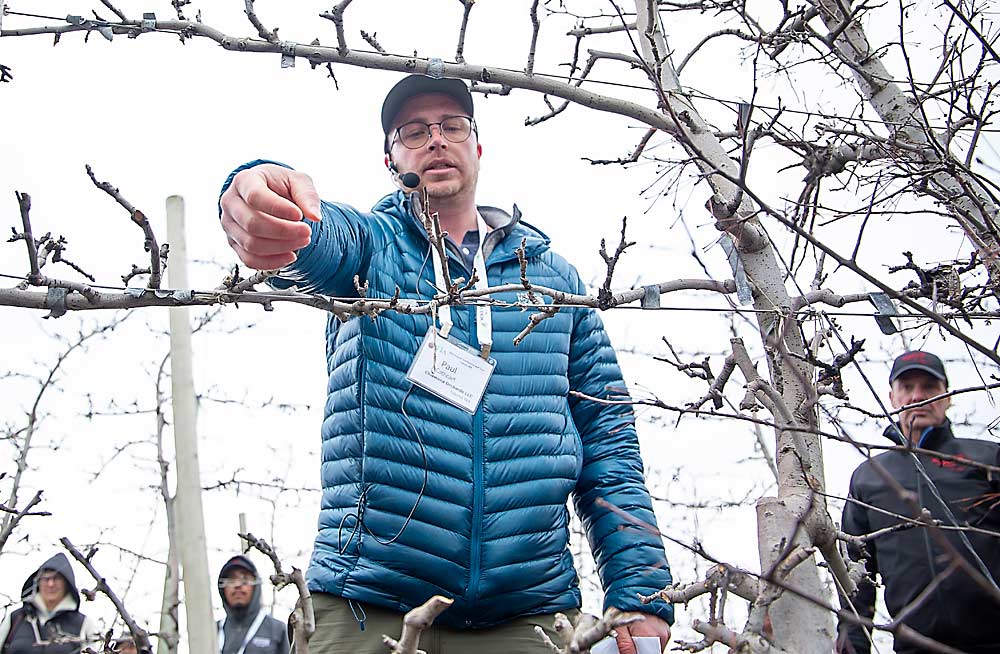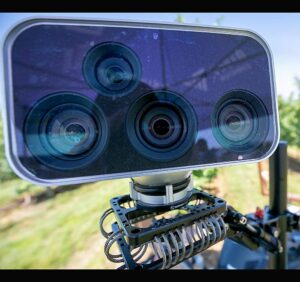
During a presentation about precision crop load management at the International Fruit Tree Association meeting in Washington in February, New York grower Mark Russell shared a photo of the high-tech sensors he relies on: his eyes.
People-powered precision provides the foundation for crop load management for Russell and his fellow panelists, Paul Cathcart, area manager for Chiawana Orchards, and Andrew del Rosario, horticulture consultant, of Washington Fruit and Produce Co.
Washington Fruit’s crop load management system includes bud sampling to understand the percentage of fruitful buds, pruning to bud count, using the precision pollen tube model for timing of lime sulfur blossom thinning, and hand blossom thinning, if necessary, with tree counts every step of the way.
All that counting costs the company some $15 to $60 an acre, estimated Gilbert Plath, the company’s technology lead, adding that the people-powered system sets a robust bar for technology companies to reach.
Del Rosario shared the math for a Gala block that the IFTA tour would visit the next day. The target fruit count is 92 apples per tree, he said, and the bud samples show that about 84 percent of the buds are fruitful, so the aim is to prune to 110 buds per tree to achieve the target crop load. (That’s calculated as target fruit count divided by the percent fruitful buds equals desired buds or 92/0.84 = 110)
He doesn’t ask pruners to count buds, however. Managers set pruning rules for each block, such as keeping at least 9 inches between stacking branches and cutting back 1-year-old wood by 6 inches, to achieve the target crop load. Managers test and refine these rules to make sure they get the desired outcome before pruners head out, and then they count again to make sure the pruning is hitting the targets.
“It gives us a signal if the counts are off and we need to change the rules,” he said.
Chiawana takes a similar approach to setting the desired crop load per tree, Cathcart said, but most orchards have some trees that are bigger than others and should carry more fruit. He sets his target, and pruning rules, for the trees that have filled space. The company counts five full-size trees per block to guide these decisions.
“If the rules are applied in the same way to a smaller tree, it will still be in proportion,” he said.
To that end, the management target — say 80 bins per acre — is set high, based on the assumption that every tree is a large tree, but in reality the block might only pick 65 or 70 because of the block variability.
He tracks the crop load through the season with digital forms that are combined with the block’s budget spreadsheets, so he can track the investment in pruning or thinning in relation to the budget.
As for the pruning rules he gives to growers, Cathcart likes to talk about fruiting “sites” on the limbs.
“Sites are buds coming off a limb where there is space for a fruit,” he said. “In a perfect world, I would only grow singles and the tree would have the same number of sites as target fruit.”
If the counts show that a block has, for example, five times more buds than he needs and 2.5 times more sites, he’ll set pruning rules to reduce the fruit sites per branch by at least half and reduce buds per site.
Russell spoke about his time-saving approach to using the Malusim fruitlet growth model to guide chemical thinning, which he nicknamed “Markusim.” The typical approach involves measuring fruitlets in 15 clusters, using calipers, repeatedly throughout the chemical thinning season to see which will persist and which will drop, and then entering that data into a spreadsheet.
Russell realized after a few years that he no longer needed the measurements to estimate which would persist, so he just started tracking estimates of developing fruitlets in each cluster, recording just 0, 1, 2 or 3 on a little note page. He uses numbered clothespins to mark the clusters during this period. Every three days, when he repeats his estimates, he can see the trends. It cut a 30-minute job for two people (one recording the data) per block down to a 15-minute job for just himself, he said.
It’s his own hack of the formal system, but “I could not do any of this without Malusim,” he said.
—by Kate Prengaman







Leave A Comment